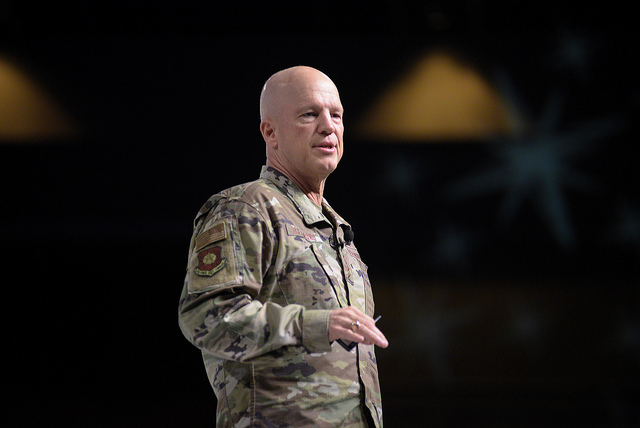
Gen. Jay Raymond speaks about space at AFA's Air Warfare Symposium on March 1, 2019, in Orlando, Fla. Staff photo by Mike Tsukamoto.
Partner nations will play a larger role in the Air Force’s military space enterprise this year as the service works to ensure its long-term dominance over the final frontier.
Space Flag, the Air Force’s premier space training exercise, will bring in coalition partners for the first time this August, Air Force Space Command chief Gen. Jay Raymond said during Friday morning remarks at AFA’s Air Warfare Symposium.
Air Force Chief of Staff Gen. David Goldfein likewise plans to convene his international counterparts for joint talks at the Space Foundation’s annual Space Symposium in April, Raymond said. That same month, the sixth iteration of Space Flag will pull in the National Reconnaissance Office as well.
Increased international outreach comes amid a recognition the military must share its data on multiple levels: between domains the Air Force oversees, each service branch, and other government agencies, as well as with America’s allies. Officials also think they can shrink the cost of space operations by combining countries’ satellites and payloads, as Russia and China develop capabilities to block others’ access to orbit.
As the Pentagon fleshes out plans to overhaul its own space organizations—among them standing up US Space Command as a unified combatant command, proposing a Space Force within the Air Force, and considering the utility of a Space Development Agency—Raymond is seen as a key figure in what comes next.
“This is an extremely exciting time to be in the space business,” he said. “We’re at the strategic inflection point where we are reliant across the joint force on space capabilities. … Assured access to space and freedom to maneuver in space [are] vital national interest[s].”
Without directly discussing the changes in the works, the nation’s top space commander called on all airmen to bring the same passion to space superiority as they do for air warfare.
Pilots need to understand space better for the future force to succeed, Raymond said, and all should embrace where industry is headed. Air Force Space Command has tried to structure its acquisition programs and start unorthodox procurement competitions to help broaden the industrial base.
One such challenge recently resulted in more than two dozen suggestions of four-dimensional data visualizations, virtual reality tools, and other technologies, according to an AFSPC release. The service rewarded the creators of eight products with about $100,000 in total.
“We said, ‘We want to have an app that will give our operators on the floor the ability to display and have better situational awareness with data that’s coming in,’” Raymond said. “We went out to non-traditional partners, universities, students. Twenty-six entries came back in and last week, we gave dollar awards for eight.”
Raymond said the best products will ultimately go to airmen at the National Space Defense Center.
A prototyping effort known as the Enterprise Space Battle Management Command and Control system is going well, Raymond said. He told Capitol Hill a year ago the operational prototype would be delivered to the Air Force Space and Missile Systems Center to begin sustainment in fiscal 2021.
Three data initiatives started by Maj. Gen. Kim Crider, the service’s former chief data officer, are already providing capability as well. Raymond did not say what those efforts entail. Crider came on as the AFSPC commander’s mobilization assistant in November and is now helping the organization build a data strategy.
The sector will continue to explode with opportunities for the taking, Raymond said.
“OneWeb, a company that’s located just down the road here, just launched their first [six] satellites of a new network that’s going to have hundreds of small satellites,” he said. “SpaceX has a constellation they’re building that’s going to have 4,000 satellites. Just think what that can do for us if we put those capabilities into the hands of warfighters and figure out how to use those to our advantage.”